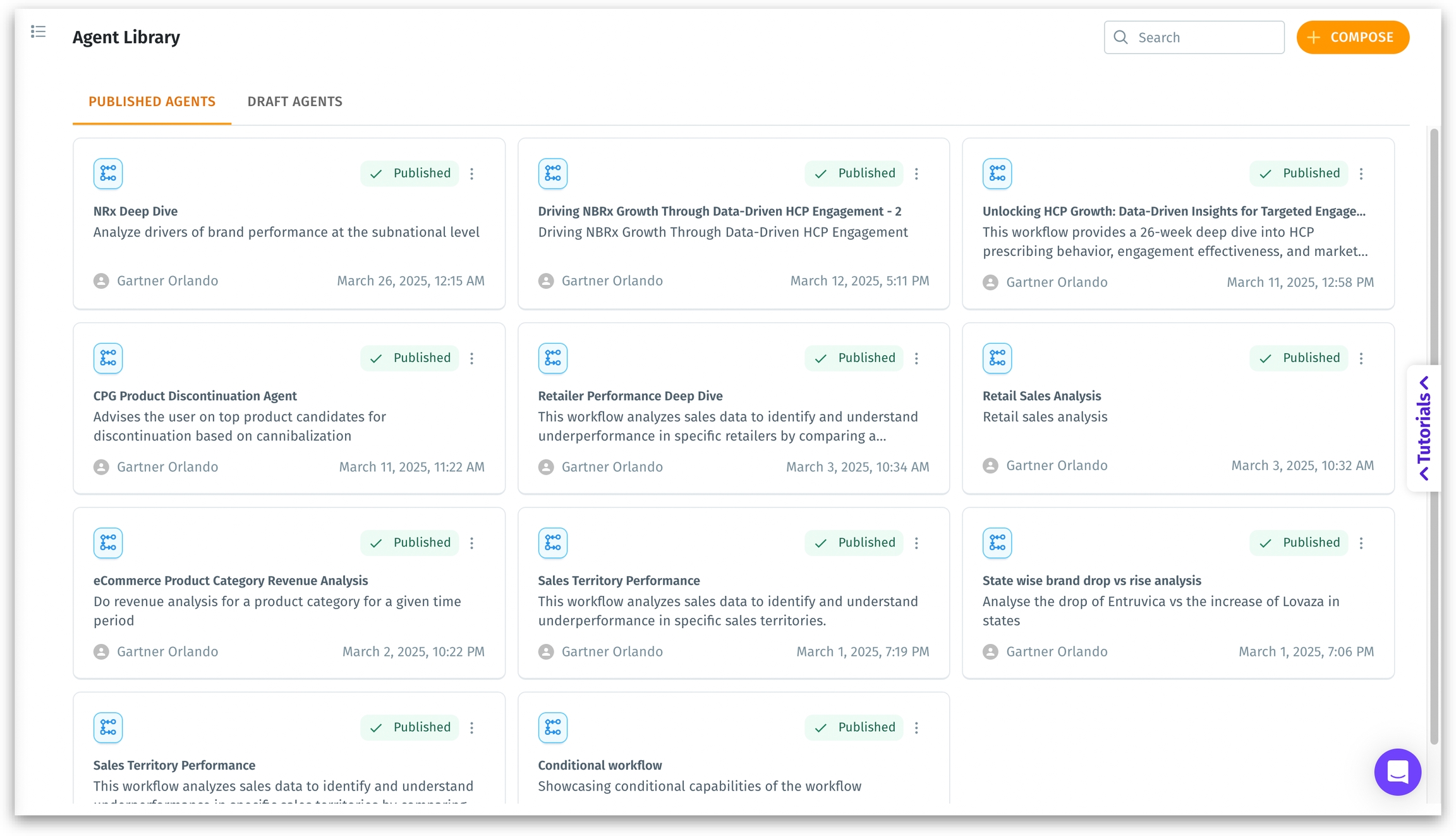Glossary
Comprehensive glossary of Kaiya AI Agents—covering validation, data prep, visualization, insights, summaries, and agentic workflows in Tellius.
AI Agents
Native, prebuilt analytical agents in Tellius designed to perform targeted tasks across the data-to-insight journey. These smart agents are reusable components that handle tasks like planning, data preparation, visualization, insight generation, and more. They are pre-trained and require no code to use. Each agent is optimized for a specific analytical function, and multiple agents can be combined to build Agentic Flows.
Validation Agent
This agent ensures the quality, safety, and feasibility of every query before it runs. It performs:
Structural validation of the input
Verification of user intent
Data availability checks
Permission enforcement
By catching issues early, the Validation Agent prevents invalid or unauthorized actions and ensures the workflow is built on reliable, clean foundations.
Planner Agent
The strategic coordinator of the workflow. When a user inputs a question or request, this agent:
Understands the task
Breaks it down into subtasks
Maps each task to the appropriate AI agent
Arranges the order of execution
Data Prep Agent
This agent handles data readiness. It automates tasks like:
Selecting relevant datasets
Applying filters and joins
Loading Business Views
Preparing structured inputs for downstream agents
It eliminates manual effort and ensures that each subsequent step in the workflow operates on clean, correct data.
Visualization Agent
This agent transforms data into visuals by:
Choosing the most appropriate visual format (charts, graphs, tables)
Generating visuals automatically based on context
Highlighting key trends and outliers visually
It helps users grasp complex data patterns at a glance without building visuals manually.
Insights Agent
A powerful analytical engine that dives deep into the data to:
Detect patterns, trends, and anomalies
Surface root causes and "why" explanations
Deliver contextual, multi-dimensional insights
This agent adds depth to dashboards by moving beyond surface-level metrics.
Summary Agent
This agent takes complex data and insights and converts them into plain-language summaries. It:
Extracts key takeaways
Generates concise narratives
Communicates the essence of analytical outputs quickly
Perfect for executive reporting or users who want the “story” behind the data without reading through charts or tables.
Knowledge Graph Agent
A relationship-mapping agent that:
Connects entities (e.g., products, customers, geographies)
Identifies hidden relationships and correlations
Powers smarter, context-aware recommendations
It enriches analysis by adding a layer of intelligence that understands the relationships behind data points.
Agentic Flow (also called: Agentic Workflow)
A complete, executable workflow composed of one or more AI Agents working together to perform a multi-step analytical task. Agentic Flows can automate:
Data validation
Data preparation
Visualization
Insight extraction
Narrative summarization
Agentic workflow steps can be defined using natural language, and the appropriate agents are orchestrated automatically. These flows are created in Composer, and can be saved, reused, and shared via the Agent Library.
Agent Library
A centralized workspace that stores and manages all user-defined Agentic Flows across the organization. It contains two sections:
Published Agents: These are fully configured, ready-to-use workflows available for execution.
Draft Agents: These are in-progress flows being built in Composer, not yet finalized or published.
Agentic flows can be edited, deleted, or duplicated from Agent Library.

Composer
A no-code development studio where you can create Agentic Flows using simple instructions in natural language. It enables business users, analysts, and data teams to build intelligent workflows without programming. Composer includes:
Name and Description: Start by naming the workflow and briefly describing its purpose.
Data Source: Connect and configure the data to be used in the workflow.
Steps: Each step is a natural language instruction that activates a specific agent.
Triggers: Define the phrases or questions that will initiate the flow. Triggers are customizable and flexible—you can set multiple variations to capture different ways you might phrase the same request. Example: For "Products to discontinue", you can set the variations "Which products should we stop selling?", "Drop candidates?", "Low-performing SKUs?".
Deep Insight
The Deep Insight button tells Kaiya to run in agentic mode (both user-defined and automated workflows). When it is on, Kaiya does multi-step planning (SQL → optional Python → summary), applies guardrails (row-level policies, fiscal calendars, join-grain checks), and returns timing, magnitude, ranked drivers, visuals, and next steps.

Last updated
Was this helpful?